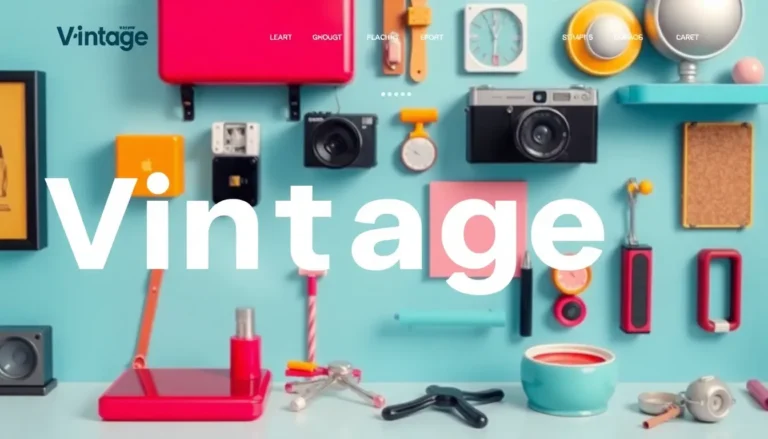In a world where first impressions matter more than ever, graphic design tools are the secret weapons that turn ordinary ideas into visual masterpieces. Whether you’re a seasoned designer or a curious newbie, the right tools can elevate your creativity and make you feel like a wizard casting spells with pixels.
Imagine having the power to create stunning graphics faster than you can say “Photoshop.” With a plethora of options available, from user-friendly apps to professional software, there’s something for everyone. So grab your digital paintbrush and get ready to explore the magic of graphic design tools that can transform your projects and maybe even impress your cat. After all, if your designs can’t win over your feline friend, are they really that good?
Table of Contents
ToggleOverview of Graphic Design Tools
Graphic design tools play a crucial role in producing visually appealing content. Users can choose from a wide range of applications tailored to specific needs, whether they are novices or professionals. Popular software options include Adobe Photoshop, widely known for its powerful image editing capabilities.
Affinity Designer serves as a strong alternative to Adobe products, offering vector graphics functionality at a lower price point. Canva appeals to those seeking simplicity, providing templates for quick design projects. Additionally, Figma stands out in collaboration features, enabling teams to work together in real-time on design tasks.
Mobile apps, such as Procreate, empower designers to create stunning graphics directly on tablets. These tools ensure accessibility for users on the go. From enhancing images to crafting layouts, each tool offers unique advantages suited to different tasks.
Consideration of user interface and learning curve is essential. Some individuals may prefer intuitive tools like Canva, while others might explore advanced functionalities in Photoshop. Prioritizing features based on project requirements leads to more effective design processes.
The affordability of many graphic design tools encourages experimentation without significant financial commitment. Free versions or trials allow users to test capabilities before investing in premium plans. This accessibility fosters creativity by allowing individuals to explore various design styles without risk.
Ultimately, each graphic design tool brings distinct strengths to the table, making it easy for users to find the right fit for their specific projects. Embracing these tools can transform ideas into striking visuals that resonate with audiences.
Types of Graphic Design Tools
Graphic design tools come in various forms, each serving unique purposes. Understanding these categories helps users select the right tools for their projects.
Vector Graphics Software
Vector graphics software specializes in creating scalable images without loss of quality. Adobe Illustrator remains a leading choice, known for its vast features and precision. Inkscape provides a free alternative, appealing to budget-conscious designers. CorelDRAW delivers robust options for professionals, especially in print design. These tools excel at producing logos, illustrations, and detailed graphics, making them essential for creating crisp designs.
Raster Graphics Software
Raster graphics software focuses on editing pixel-based images. Adobe Photoshop stands out for its advanced features, catering to photographers and graphic designers alike. GIMP serves as a powerful free alternative, offering ample editing capabilities. Affinity Photo offers a cost-effective option without compromising on functionality. Users typically employ these tools for photo manipulation, web graphics, and digital painting, emphasizing detailed imagery and rich textures.
3D Design Software
3D design software enables the creation of three-dimensional models and animations. Blender provides a free, open-source solution with extensive capabilities. Autodesk Maya remains popular among professionals for character animation and visual effects. Cinema 4D is favored for its user-friendly interface and motion graphics tools. Users generally utilize these applications for game design, architectural visualization, and product modeling, highlighting the growing demand for 3D content.
Layout and Typography Tools
Layout and typography tools aid in arranging text and images effectively. Adobe InDesign stands out for its comprehensive layout features, ideal for magazine and book design. Affinity Publisher offers an affordable alternative with similar capabilities. Canva provides a user-friendly interface for quick projects with pre-designed templates. These tools enhance overall design coherence and ensure that typography complements visuals, making them vital for print and digital media.
Popular Graphic Design Tools
Graphic design tools play a vital role in shaping solid visual content. Here’s a look at some popular options.
Adobe Creative Cloud
Adobe Creative Cloud stands as a leading suite for design professionals. It offers a comprehensive range of tools, including Photoshop for photo editing and Illustrator for vector graphics. Advanced features cater to precise design needs. Users appreciate regular updates that keep the software at the forefront of design technology. Subscription pricing allows access to the latest versions, ensuring projects benefit from new capabilities.
CorelDRAW
CorelDRAW delivers a robust platform for vector illustration and layout design. The user-friendly interface appeals to both newcomers and experienced designers. Features such as creative templates streamline the design process. Specialized tools help users create stunning graphics with ease and precision. Additionally, compatibility with multiple file formats enhances its versatility in professional environments.
Canva
Canva simplifies graphic design with its intuitive drag-and-drop interface. Ideal for beginners, it offers countless templates and design elements. Users can create social media graphics, posters, and presentations quickly. The platform includes collaboration features, allowing teams to work together effortlessly. Free and paid plans provide flexibility depending on project requirements.
Affinity Designer
Affinity Designer stands out as a budget-friendly alternative to Adobe products. It combines vector and raster creation in one application, appealing to diverse design needs. Speedy performance maximizes efficiency during workflows. Frequent updates ensure users access new tools regularly. With a one-time purchase model, it offers excellent value for designers seeking quality software without ongoing fees.
Factors to Consider When Choosing Graphic Design Tools
Selecting the right graphic design tools involves several important factors. Users prioritize these elements based on their specific needs.
User Interface and Usability
User interface affects how intuitive a tool feels. A clean, organized layout streamlines the design process. Beginners benefit from tools with simple navigational structures. Advanced users may prefer options that offer extensive functionality while maintaining usability. Quick online tutorials often enhance learning and user confidence. Tools with a supportive community provide additional resources and insights. Consistent updates can improve the overall user experience further.
Features and Functionality
Feature sets determine a tool’s versatility. Essential functions include image editing capabilities, typography options, and collaboration features. Tools that support various formats cater to a wider range of projects. Advanced features like vector creation or 3D modeling appeal to more experienced designers. Integration with other software increases efficiency for seamless workflows. The ability to customize workflows optimizes the user experience. Many free trials allow users to evaluate features before deciding.
Cost and Licensing Options
Cost impacts accessibility for many users. Some tools offer one-time purchases, while others follow subscription models. Budget constraints often dictate which tools users select. Many free options exist, but feature limitations might affect usability. Educational discounts provide access for students and teachers. Users should weigh long-term costs against initial investment. Assessing trial periods allows exploration without commitment before making a financial decision.
Conclusion
Choosing the right graphic design tools can significantly impact the quality and effectiveness of visual projects. With a plethora of options available from user-friendly apps to advanced software, designers can find solutions that cater to their specific needs. Whether it’s creating stunning graphics for social media or developing intricate designs for print, the right tools make all the difference.
Experimenting with various tools allows individuals to discover their preferences and enhance their skills. By leveraging free trials and exploring different functionalities, users can confidently select the best options for their creative endeavors. Embracing these graphic design tools not only boosts creativity but also elevates overall project outcomes, ensuring impressive results that resonate with audiences.



